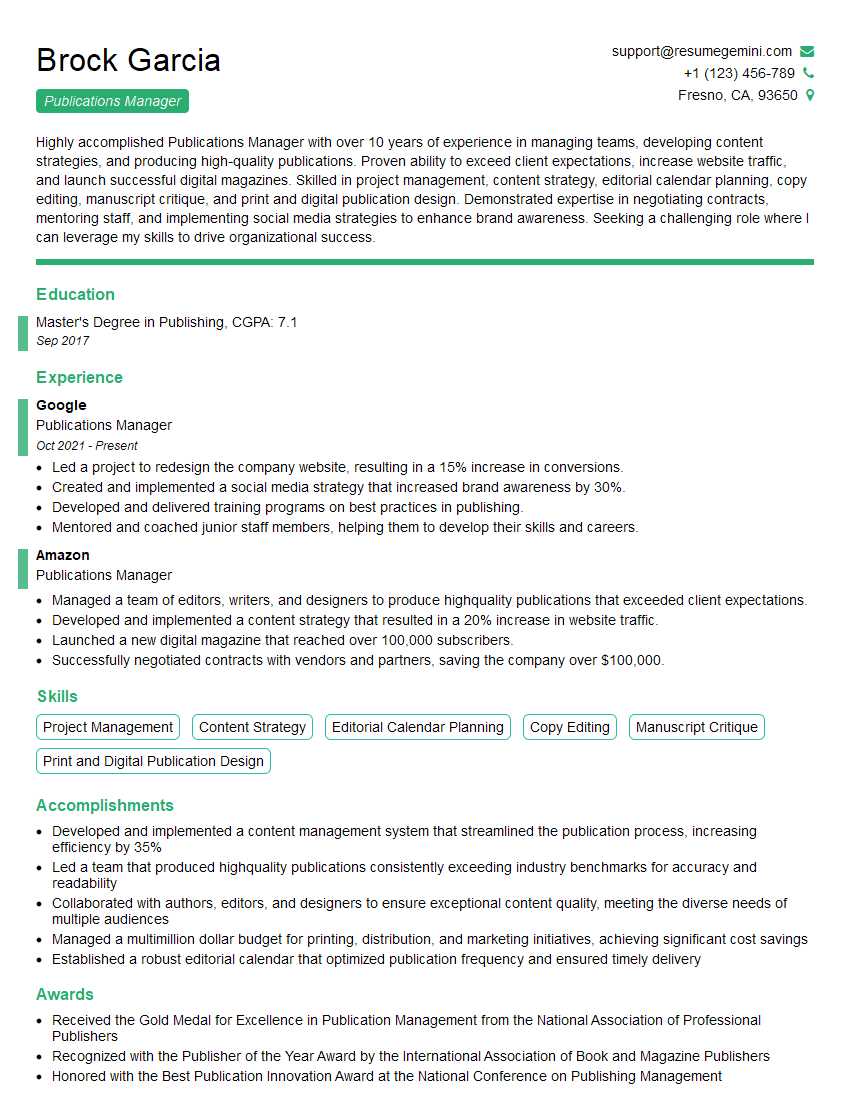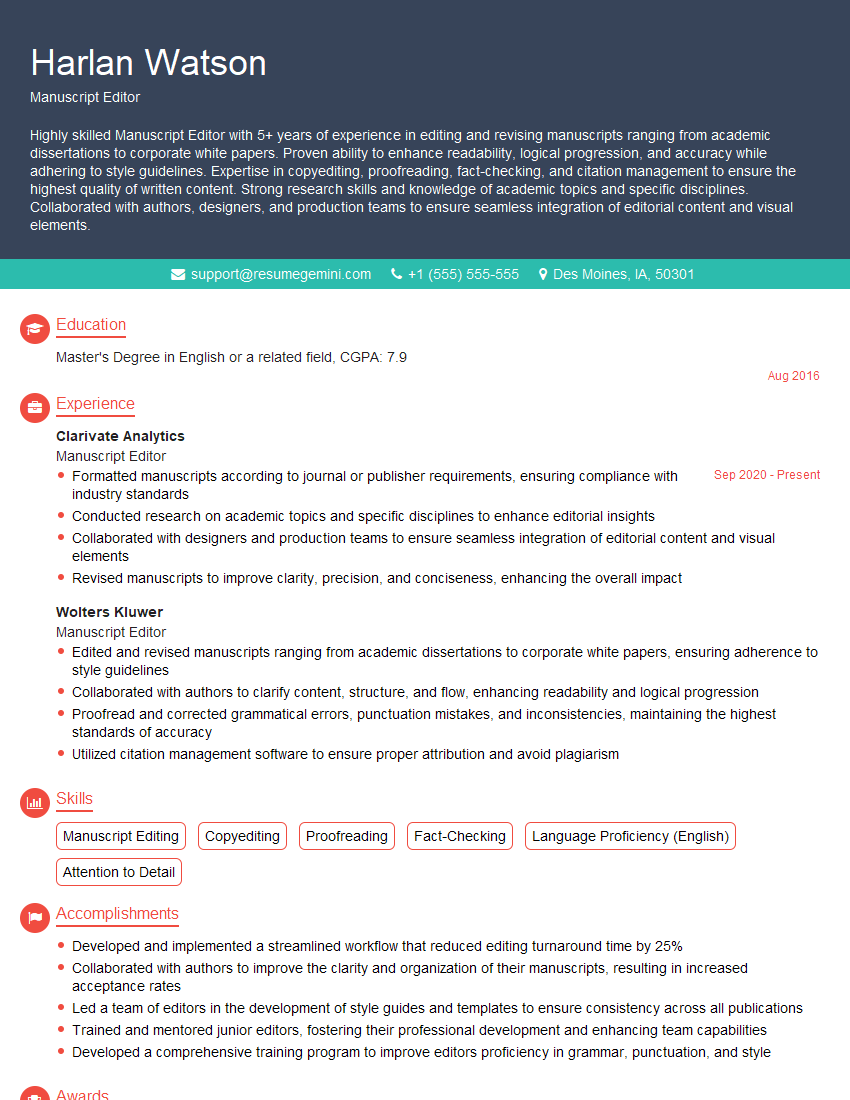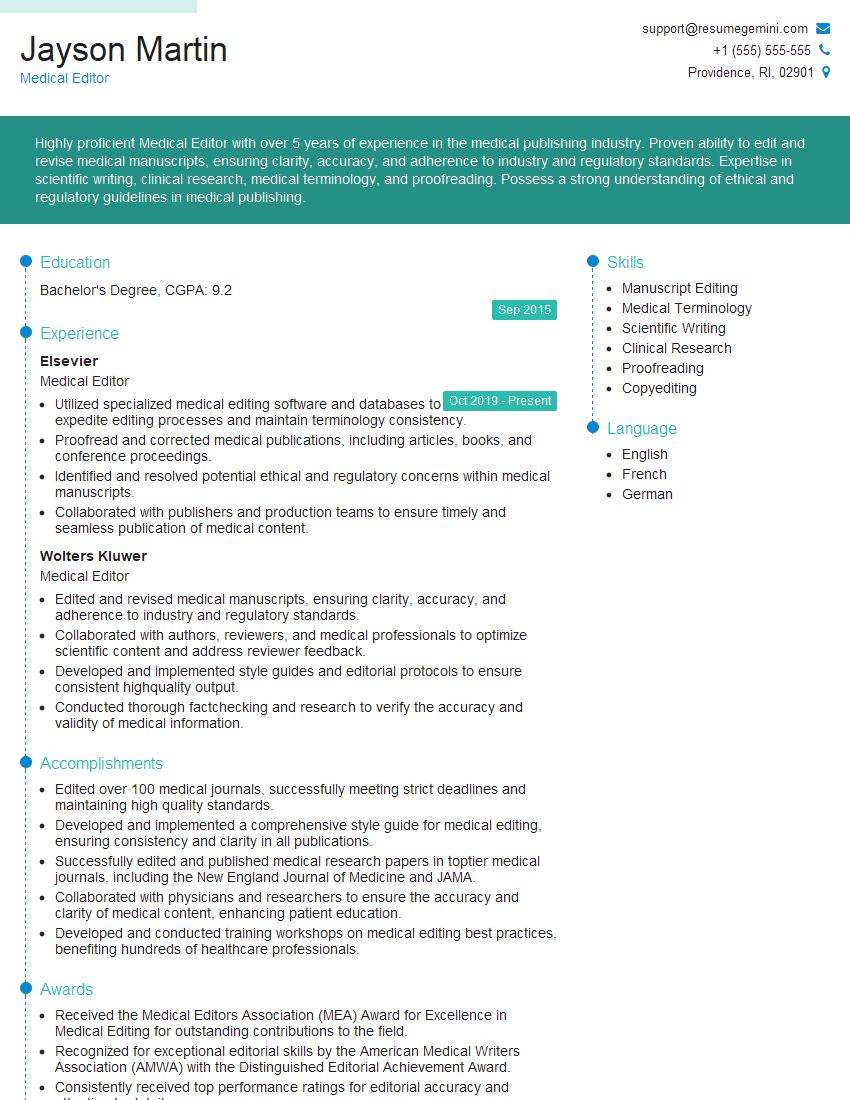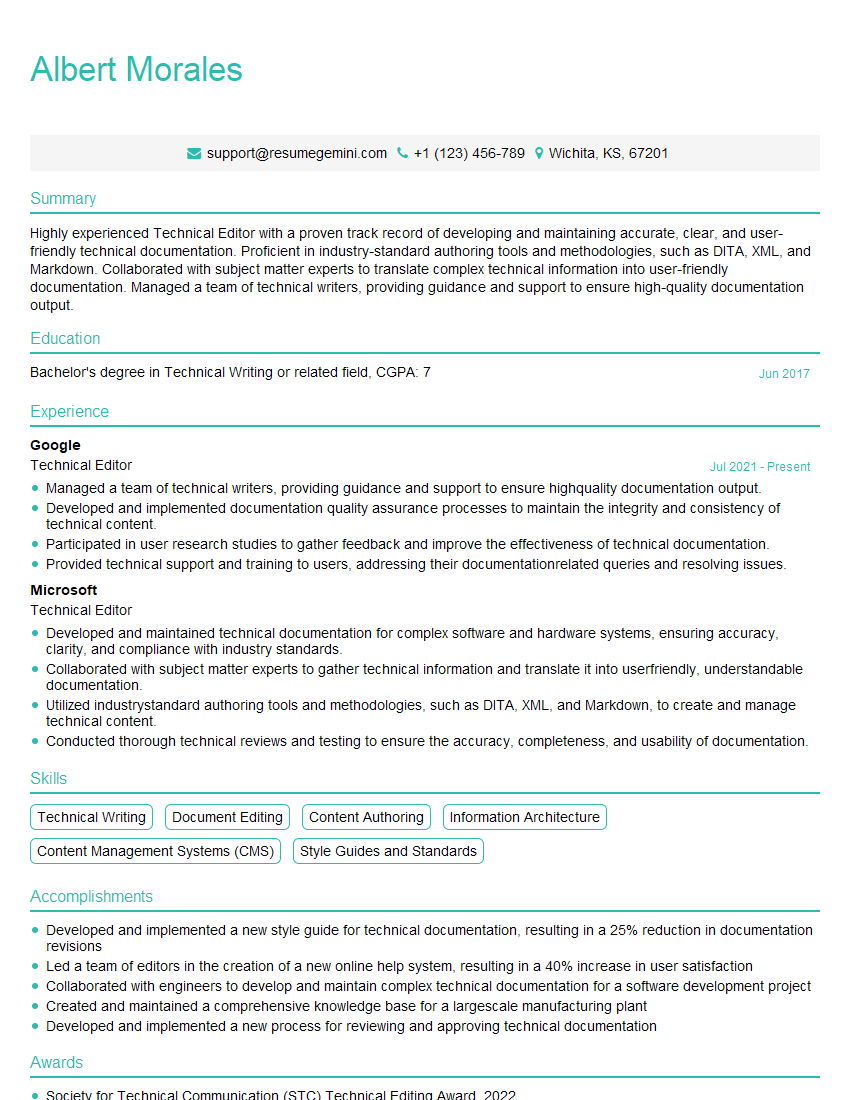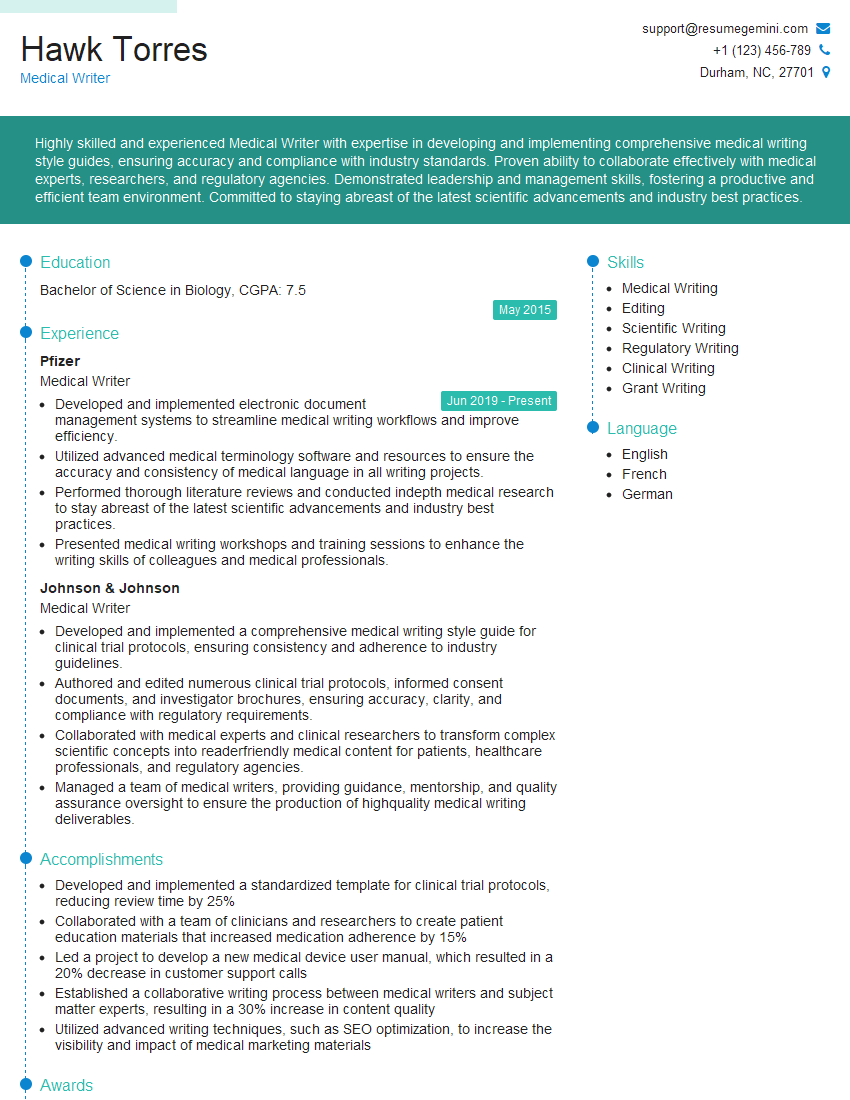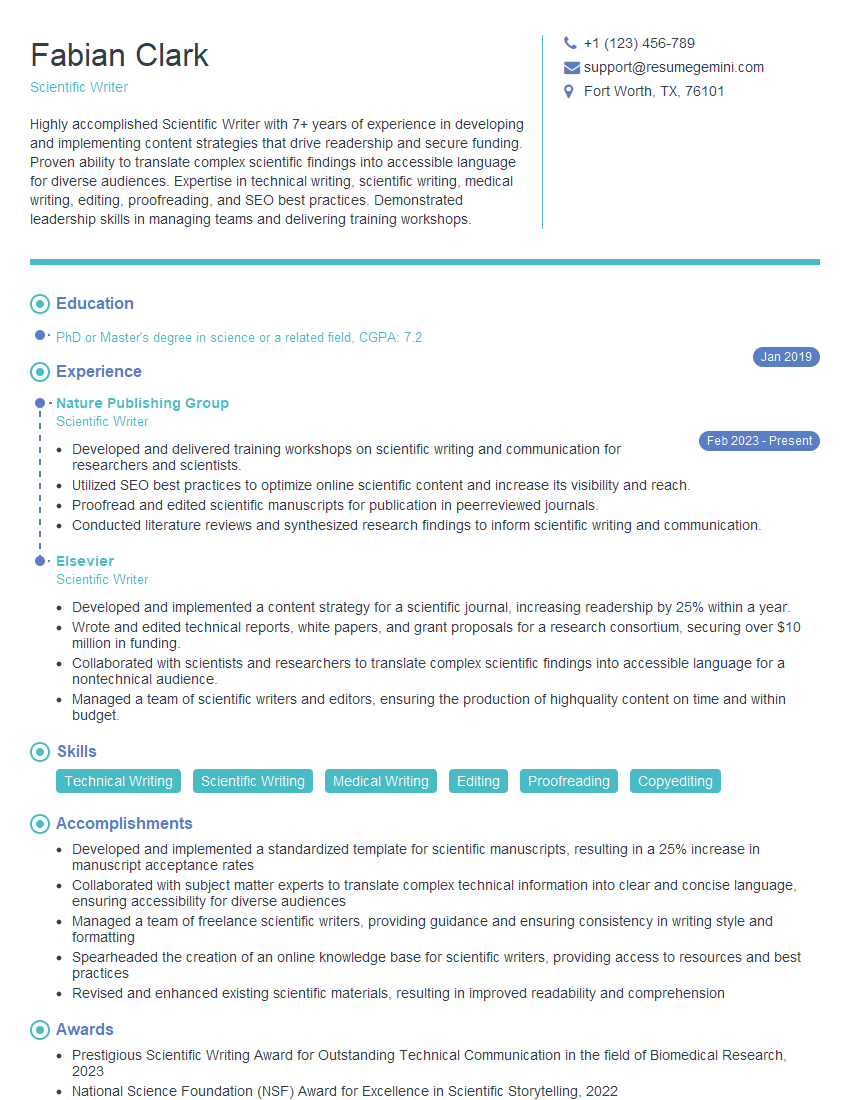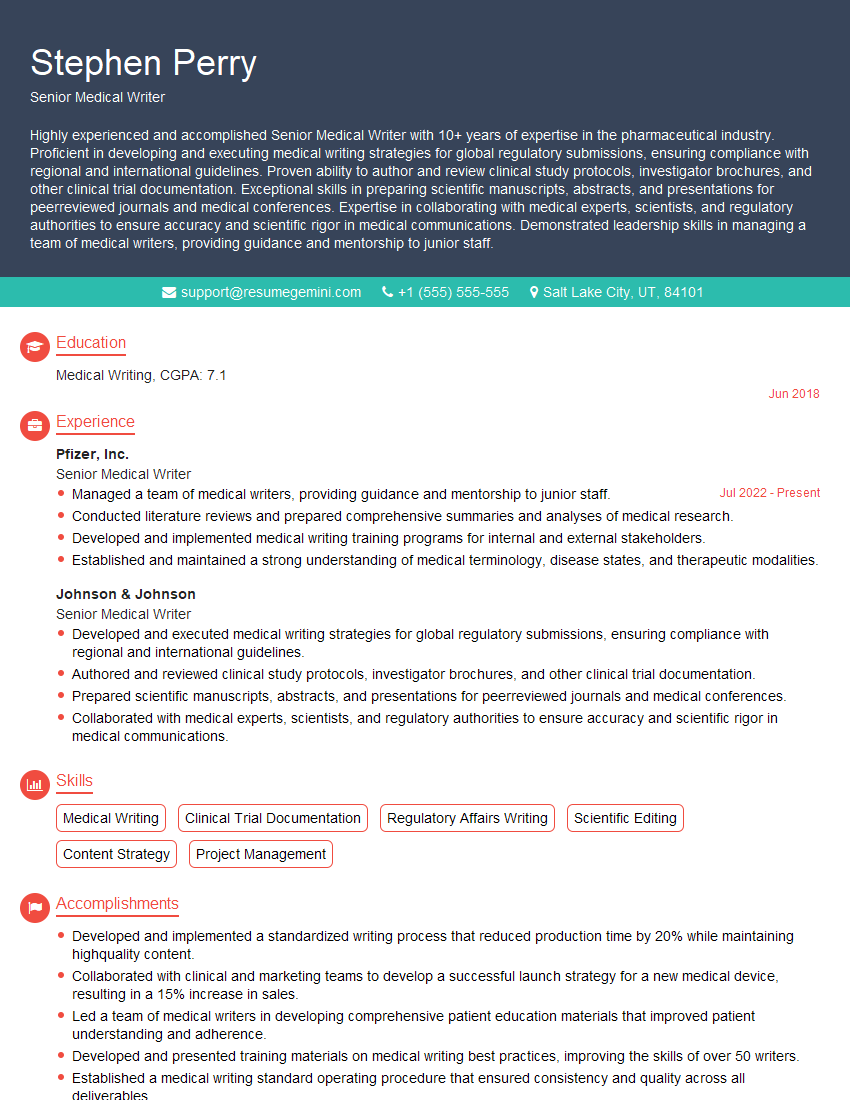Every successful interview starts with knowing what to expect. In this blog, we’ll take you through the top Scientific Writing and Editing interview questions, breaking them down with expert tips to help you deliver impactful answers. Step into your next interview fully prepared and ready to succeed.
Questions Asked in Scientific Writing and Editing Interview
Q 1. Explain the difference between scientific writing and technical writing.
While both scientific and technical writing aim to communicate complex information clearly, they differ significantly in their purpose and audience. Scientific writing focuses on reporting original research findings to the scientific community, emphasizing rigorous methodology, data analysis, and objective conclusions. It typically follows a structured format, including an abstract, introduction, methods, results, discussion, and conclusion. Technical writing, on the other hand, aims to instruct or inform a specific audience on how to use a product, process, or system. It prioritizes clarity, conciseness, and practicality, often using visual aids like diagrams and flowcharts. Think of a scientific paper detailing the effects of a new drug versus a user manual explaining how to operate a piece of medical equipment – both are highly technical, but their objectives and target audiences are quite distinct.
For example, a scientific paper on climate change would detail experimental methodologies, statistical analyses, and interpretations of the findings, aiming to contribute to the body of scientific knowledge. A technical document on carbon capture technology, conversely, would focus on explaining the system’s operation, maintenance, and safety protocols to engineers and technicians.
Q 2. Describe your experience with different citation styles (e.g., APA, MLA, Chicago).
I’m proficient in several citation styles, including APA, MLA, and Chicago. My experience spans various academic disciplines, from biology and chemistry to engineering and the social sciences. I understand the nuances of each style, including in-text citations, reference list formatting, and the appropriate use of footnotes or endnotes. For instance, I know that APA emphasizes author-date citations, MLA uses author-page citations, and Chicago offers various options, including author-date and notes-bibliography systems. I’ve successfully managed hundreds of citations across numerous projects, ensuring accuracy and consistency throughout complex documents.
The ability to quickly adapt to different citation styles is crucial for me. I use citation management software like Zotero or Mendeley to streamline the process and minimize errors, ensuring that all sources are accurately attributed and formatted correctly according to the chosen style guide.
Q 3. How do you ensure accuracy and clarity in scientific writing?
Ensuring accuracy and clarity in scientific writing requires a multi-faceted approach. It starts with a meticulous review of the source material, verifying data points, statistical analyses, and the validity of interpretations. I carefully scrutinize methodologies, ensuring they are adequately described and justifiable. I also look for inconsistencies or potential biases that could affect the reliability of the findings.
Clarity is achieved through careful sentence construction, precise word choice, and logical organization of information. I pay close attention to transitions between paragraphs, ensuring a smooth and coherent flow of ideas. I strive for conciseness without sacrificing precision, avoiding jargon or overly technical language unless absolutely necessary, and always defining any specialized terms. A final read-through or proofreading by a fresh set of eyes is always helpful to catch any remaining errors.
Q 4. What strategies do you use to edit complex scientific information for a lay audience?
Editing complex scientific information for a lay audience requires a significant shift in approach. The key is to simplify complex concepts without sacrificing accuracy. This involves breaking down technical jargon into easily understandable language, using analogies and metaphors to illustrate complex processes, and structuring the information in a more narrative style. I often use visual aids like infographics and diagrams to enhance comprehension. The goal is to create a story that is engaging and informative, allowing the reader to grasp the essence of the scientific findings without needing a specialized scientific background. I may also incorporate case studies or examples that make the information more relatable and memorable.
For example, instead of explaining complex statistical analysis, I might focus on the overall trend and its implications for the average person. A technical description of a medical procedure can be explained using layman’s terms, focusing on the basic steps and potential benefits or risks.
Q 5. How familiar are you with peer review processes?
I am very familiar with peer review processes. I understand their crucial role in quality control and the advancement of scientific knowledge. I’ve been involved in several peer-review processes, both as a reviewer and as an author. I appreciate the constructive criticism offered by reviewers and the importance of responding to their comments thoughtfully and professionally. I know the process involves critical evaluation of the methodology, results, and overall presentation of the research, ensuring the rigor and validity of the published work.
This experience has given me valuable insights into the expectations and standards required for high-quality scientific publications. I understand the importance of transparency, objectivity, and reproducibility in scientific research and strive to incorporate these principles in my own writing and editing work.
Q 6. Describe your experience working with scientific figures and tables.
Working with scientific figures and tables is a fundamental aspect of my work. I understand the importance of creating clear, concise, and accurate visuals that effectively communicate the data. I can work with various software packages such as Adobe Illustrator, Photoshop, and Microsoft Excel to create and edit figures and tables, ensuring they are appropriately labeled, captioned, and formatted. I pay close attention to detail, ensuring data accuracy and consistency between the figures/tables and the text. I also prioritize visual clarity, choosing appropriate scales and chart types to best represent the data. I have extensive experience in ensuring that figures and tables are both visually appealing and scientifically sound, contributing significantly to the overall impact of the scientific work.
For example, I can advise on the best way to display complex multivariate data, choosing between scatter plots, heat maps, or other suitable visualization techniques. I’m skilled at ensuring accessibility for those with visual impairments.
Q 7. How do you handle conflicting information from multiple sources?
Handling conflicting information from multiple sources requires a systematic approach. It involves critically evaluating the credibility and reliability of each source, considering factors such as the author’s expertise, the publication’s reputation, and the methodology used to obtain the information. I might also look at the date of publication, considering how recent and up-to-date the information is. If the conflict is significant, I try to identify the root cause of the discrepancy. Sometimes, a deeper literature review may be necessary to find additional information to resolve the conflict. In some cases, I might clearly state the existence of conflicting viewpoints and their implications. It’s vital to be transparent about any uncertainties or limitations in the available data and to present the information in a balanced and objective manner.
For instance, when reviewing literature on a specific scientific topic, encountering conflicting findings might lead me to examine the underlying methodologies, sample sizes, or potential biases of each study, providing context to help the reader understand the limitations of the evidence.
Q 8. How do you manage deadlines and prioritize tasks in a fast-paced environment?
Managing deadlines and prioritizing tasks in a fast-paced scientific writing and editing environment requires a strategic approach. I utilize project management techniques like breaking down large projects into smaller, manageable tasks. This allows me to create a detailed timeline with realistic deadlines for each component. I employ tools like Trello or Asana to visually track progress and identify potential bottlenecks.
Prioritization is key. I use methods such as the Eisenhower Matrix (urgent/important) to focus on high-impact tasks first. For example, if I have a manuscript needing final proofreading and another requiring a substantial literature review, I would prioritize the proofreading, as it’s closer to the deadline and a quicker task. This prevents last-minute rushes and ensures quality. Regular review of my to-do list and proactive communication with clients regarding potential delays are essential parts of my workflow.
Q 9. What software and tools are you proficient in for scientific writing and editing?
My proficiency spans a range of software and tools crucial for scientific writing and editing. I’m highly adept at using Microsoft Word and its advanced features like track changes, styles, and macros, essential for collaboration and consistency. I also have extensive experience with LaTeX, a powerful typesetting system commonly used in scientific publications, particularly for complex mathematical equations and formatting. Furthermore, I am comfortable using reference management software like Zotero and Mendeley to ensure accurate and consistent citations. Finally, I am proficient in using online collaborative platforms like Google Docs for real-time editing and feedback integration.
Q 10. Describe your experience with style guides and their application.
Style guides are the bedrock of consistent and professional scientific writing. My experience encompasses a wide variety of guides, including the AMA Manual of Style, the CSE Manual for Authors, Editors, and Publishers, and the Chicago Manual of Style. I understand the nuances of each guide and can apply the appropriate one depending on the journal or publication’s requirements. For example, the AMA style emphasizes brevity and clarity in medical writing, while CSE caters to natural and physical sciences. Beyond simply following formatting rules, I understand the underlying principles of each style guide, which allows me to make stylistic choices that enhance the clarity and readability of the scientific text while adhering to the specified standards.
Q 11. How do you ensure the ethical conduct of your writing and editing work?
Ethical conduct is paramount in my work. I always strive to maintain the integrity of the scientific process. This includes ensuring proper attribution of sources, avoiding plagiarism (even unintentional), and accurately representing the research findings. I meticulously review manuscripts for potential conflicts of interest and report any concerns to the appropriate parties. Confidentiality is crucial; I treat all submitted material with the utmost discretion. If I detect any discrepancies or potential ethical violations during my editing process, I will immediately bring it to the author’s attention and work collaboratively to resolve the issue, always prioritizing honesty and transparency.
Q 12. How do you handle feedback from authors and editors?
Handling feedback is a collaborative process. I actively seek feedback from both authors and editors, viewing it as an opportunity to improve the manuscript. I always respond promptly to any comments, clarifying any misunderstandings and addressing concerns thoroughly. I explain my editing decisions clearly, providing justification when necessary. When disagreements arise, I approach them constructively, aiming for a mutually satisfactory outcome that upholds scientific rigor and clarity. Effective communication is key—I ensure that all feedback is acknowledged, whether it is accepted or not, and that any changes made are clearly documented using tools like track changes.
Q 13. Describe your experience with copy editing, proofreading, and fact-checking.
My experience encompasses the entire editing spectrum. Copy editing involves refining the writing style, ensuring clarity, consistency, and adherence to style guidelines. Proofreading focuses on detecting typographical errors, grammatical inconsistencies, and inconsistencies in formatting. Fact-checking ensures that the data presented is accurate and verifiable, often involving cross-referencing with multiple sources. For instance, I might copy edit a manuscript to improve sentence structure and clarity, then proofread the final version for any lingering errors before a final round of fact-checking to ensure figures and data match source material. Each stage is crucial to delivering a polished, error-free, and scientifically sound final product.
Q 14. How do you identify and correct grammatical errors, typos, and inconsistencies?
Identifying and correcting errors involves a multi-pronged approach. I use a combination of automated tools like Grammarly and ProWritingAid to catch common errors, but I always rely on my own careful reading and editing skills to ensure accuracy. I focus on common mistakes such as subject-verb agreement, tense consistency, punctuation errors, and misused words. My process involves multiple readings, each focusing on different aspects of the text. For instance, one read might focus on grammar, another on style, and a final one on consistency and accuracy. Understanding the context is crucial; sometimes what initially seems like an error might be a valid stylistic choice within the specific scientific field.
Q 15. Explain your understanding of plagiarism and how you avoid it.
Plagiarism is the representation of another author’s language, thoughts, ideas, or expressions as one’s own original work. It’s a serious breach of academic and professional ethics. Avoiding plagiarism requires meticulous attention to detail and a robust understanding of proper citation practices.
- Careful Note-Taking: I always meticulously document my sources, clearly distinguishing between my own ideas and those I’ve gathered from others. This includes noting page numbers, specific sections, and any paraphrased content.
- Consistent Citation: I’m proficient in various citation styles (APA, MLA, Chicago, etc.) and apply them consistently throughout my work. I ensure all borrowed information, whether direct quotes or paraphrases, is accurately attributed to its source.
- Paraphrasing and Summarizing: Instead of directly copying text, I rephrase information in my own words, ensuring I understand the underlying concepts before presenting them. This demonstrates my comprehension and avoids plagiarism.
- Quotation Marks: Direct quotes are always enclosed in quotation marks, and their source is immediately cited.
- Software Tools: I utilize plagiarism detection software, such as Turnitin, to scan my work before submission, ensuring no unintentional plagiarism has slipped through.
For instance, if I’m writing about a specific study, I’ll carefully paraphrase its findings and cite the original research paper. I’ll never copy and paste sections without proper attribution. My approach prioritizes intellectual honesty and transparency.
Career Expert Tips:
- Ace those interviews! Prepare effectively by reviewing the Top 50 Most Common Interview Questions on ResumeGemini.
- Navigate your job search with confidence! Explore a wide range of Career Tips on ResumeGemini. Learn about common challenges and recommendations to overcome them.
- Craft the perfect resume! Master the Art of Resume Writing with ResumeGemini’s guide. Showcase your unique qualifications and achievements effectively.
- Don’t miss out on holiday savings! Build your dream resume with ResumeGemini’s ATS optimized templates.
Q 16. How do you ensure readability and accessibility in your writing?
Readability and accessibility are paramount for effective scientific communication. I strive to make my writing clear, concise, and easy to understand for a wide audience, regardless of their background in the subject matter. This involves several strategies:
- Plain Language: I avoid jargon and technical terms whenever possible. If technical terms are necessary, I define them clearly. Think of it like explaining a complex scientific concept to a curious but uninformed friend.
- Sentence Structure: I use short, focused sentences with active voice. This improves clarity and makes the text easier to follow.
- Logical Flow: My writing follows a logical structure, with clear transitions between paragraphs and sections to guide the reader smoothly through the information.
- Visual Aids: I effectively use visuals, such as tables, graphs, and figures, to complement the text and present data in a more accessible format.
- Accessibility Features: I ensure my documents adhere to accessibility guidelines (e.g., WCAG) by using appropriate headings, alt text for images, and ensuring sufficient color contrast.
For example, instead of writing ‘The in vitro analysis demonstrated a statistically significant elevation in the biomarker X…’, I might write ‘Laboratory tests showed a significant increase in biomarker X…’ This makes the information more readily understandable for a broader audience.
Q 17. How do you approach editing complex scientific data for publication?
Editing complex scientific data for publication is a multi-step process requiring careful attention to detail, accuracy, and clarity. It’s crucial to ensure the data is accurately represented and interpreted. My approach involves:
- Data Verification: I thoroughly verify the accuracy of the data, checking for inconsistencies, outliers, and potential errors. This may involve collaborating with the researchers to clarify any ambiguities.
- Data Presentation: I work with the authors to select the most appropriate method for presenting the data (tables, figures, graphs). The choice depends on the nature of the data and the intended audience.
- Statistical Analysis: I ensure that the statistical analysis is correctly performed and reported, including appropriate measures of uncertainty and error.
- Clarity and Conciseness: I make sure the data is presented in a clear, concise, and easy-to-understand manner, avoiding unnecessary technical jargon.
- Consistency and Style: I maintain consistency in style, units, and formatting throughout the manuscript.
For instance, if a graph is misleading or doesn’t effectively represent the data, I’ll work with the authors to revise it. If there are inconsistencies in the statistical analysis, I’ll identify them and propose corrections.
Q 18. Describe your experience working with different types of scientific publications.
I’ve worked with a diverse range of scientific publications, including:
- Journal Articles: I have experience editing research articles for peer-reviewed journals across various scientific disciplines, ensuring they meet the journal’s specific guidelines.
- Conference Proceedings: I’ve edited abstracts, posters, and full papers for scientific conferences, often adapting the style and length to suit the specific event.
- Book Chapters: I’ve contributed to editing book chapters in scientific textbooks and edited collections, focusing on consistency and coherence across the entire work.
- Grant Proposals: I’ve assisted in preparing grant proposals, ensuring they effectively communicate the research project’s significance and methodology.
- Technical Reports: I’ve edited technical reports for government agencies and private companies, adhering to specific reporting standards.
Each publication type requires a slightly different approach to editing, but my core principles of clarity, accuracy, and adherence to style guidelines remain consistent.
Q 19. How familiar are you with regulatory guidelines for scientific writing (e.g., FDA)?
I am very familiar with regulatory guidelines for scientific writing, particularly those pertaining to the FDA (Food and Drug Administration). This includes understanding the requirements for:
- Clinical Trial Reporting: I understand the importance of accurate and complete reporting of clinical trial data, following ICH-GCP guidelines and ensuring compliance with regulatory standards.
- Drug Labeling and Packaging: I’m familiar with FDA guidelines on the language used in drug labeling and packaging, ensuring clarity and accuracy to avoid misleading the consumer.
- Submission Documentation: I have experience in preparing regulatory submissions to the FDA, ensuring all necessary documentation is included and formatted correctly.
- Advertising and Promotion: I understand the restrictions on the advertising and promotion of pharmaceuticals and medical devices, ensuring compliance with FDA regulations.
Failure to comply with FDA guidelines can have severe consequences, including delays in product approval and potential legal action. My focus is always on ensuring meticulous adherence to these standards.
Q 20. How do you stay up-to-date with the latest trends in scientific writing and editing?
Staying current in scientific writing and editing is crucial. I achieve this through a multifaceted approach:
- Professional Organizations: I actively engage with professional organizations such as the American Medical Writers Association (AMWA) and the Council of Science Editors (CSE), attending conferences and webinars, and reading their publications.
- Peer-Reviewed Journals: I regularly read peer-reviewed journals in scientific communication and related fields to stay abreast of current trends and best practices.
- Online Resources: I utilize online resources and databases such as PubMed and Google Scholar to access up-to-date information and research on scientific writing techniques.
- Continuing Education: I participate in workshops, short courses, and online training programs to enhance my skills and knowledge in scientific writing and editing.
- Mentorship and Collaboration: I engage in mentorship and collaborative projects with seasoned professionals, exchanging best practices and learning from their expertise.
By continuously learning and updating my skills, I can maintain the highest standards of quality and relevance in my work.
Q 21. Describe your experience collaborating with scientists and researchers.
Collaboration is a cornerstone of my work. I have extensive experience working with scientists and researchers from diverse backgrounds and disciplines. My approach emphasizes:
- Active Listening: I carefully listen to the researchers’ ideas and perspectives, ensuring I thoroughly understand their research before beginning the editing process.
- Clear Communication: I maintain clear and open communication throughout the project, keeping researchers informed of my progress and seeking their input when needed.
- Respectful Feedback: I provide constructive and respectful feedback, offering suggestions for improvement without undermining the researchers’ expertise.
- Collaborative Editing: I use collaborative editing tools (e.g., Google Docs, Microsoft Word’s Track Changes) to facilitate a seamless and efficient editing process.
- Understanding Research Context: I recognize that scientific writing is not simply about grammar and style; it’s about effectively conveying complex scientific findings within their appropriate context.
For example, I might work closely with a research team to clarify the implications of their findings and ensure they are presented accurately and persuasively to their intended audience. Building trust and mutual respect is key to a successful collaboration.
Q 22. How do you handle ambiguity and uncertainty in scientific information?
Ambiguity and uncertainty are inherent in the scientific process. Handling them effectively requires a multi-pronged approach. First, I meticulously examine the source material, identifying areas of vagueness or conflicting data. This often involves cross-referencing with multiple sources to corroborate findings. Second, I employ clear and precise language, carefully qualifying statements to reflect the level of uncertainty. For instance, instead of writing ‘this method always works,’ I might write ‘this method generally yields reliable results under the specified conditions, although variations have been observed in X and Y contexts.’ Third, I might use probability language to convey uncertainty, stating, for example, that ‘results suggest a high probability (95% confidence interval) of Z occurring’. Finally, I discuss limitations explicitly, acknowledging any biases, gaps in the data, or alternative interpretations.
For example, imagine a study on a new drug. If the results show a positive effect, but the sample size is small, I would clearly state the limitations of the findings and suggest further research with a larger sample size is needed before drawing definitive conclusions. This is critical for maintaining scientific integrity and avoiding overstated claims.
Q 23. What is your experience with using various types of scientific data representations?
My experience encompasses a wide range of data representations, including tabular data (spreadsheets, databases), graphical representations (charts, graphs, maps), statistical outputs (regression analysis results, p-values), and multimedia (images, videos). I am proficient in interpreting and presenting data in the most effective format for the intended audience and the context of the study. For example, I would not present complex statistical data in a popular science article; rather, I would use illustrative visuals and plain language to convey the key findings. Conversely, a peer-reviewed publication would require a more rigorous and detailed statistical presentation. I am also comfortable working with various software programs used for data analysis and visualization such as R, SPSS, and GraphPad Prism.
Q 24. How would you improve the clarity of a poorly written scientific abstract?
Improving a poorly written scientific abstract requires a systematic approach. First, I would identify the core issues – is it too long, too vague, poorly structured, or lacking key information? Then, I would restructure the abstract to adhere to the IMRaD format (Introduction, Methods, Results, Discussion) even in the condensed form of an abstract. This provides a logical flow. Next, I would refine the language, removing jargon and replacing ambiguous phrasing with clear, concise language. Quantitative results should be presented accurately and precisely. Finally, I would ensure the abstract accurately reflects the content of the full manuscript. For instance, if the study revealed unexpected results or limitations, the abstract should reflect this accurately.
Imagine an abstract that states, ‘The results were interesting.’ This is too vague. I would replace this with a more precise statement such as, ‘The experiment yielded unexpected results, showing a significant increase in X under condition Y (p<0.05), challenging the current hypothesis.’ This improved version provides far more information and context.
Q 25. How do you ensure consistency of style and terminology across a scientific document?
Consistency of style and terminology is paramount in scientific writing. I employ a combination of strategies to achieve this. First, I use a style guide (e.g., APA, MLA, Chicago) consistently throughout the document. These guides provide rules on everything from citation formats to capitalization. Second, I create a style sheet specifically for the document, listing any non-standard terminology or preferred phrasing. This ensures consistency in definitions and abbreviations. Third, I utilize track changes and comments in word-processing software to manage revisions and ensure everyone involved in the writing process adheres to the established style. Finally, I meticulously proofread the final draft to catch any inconsistencies.
For example, if a paper refers to ‘blood pressure’ throughout most of the text but then uses ‘BP’ in one section, this inconsistency can be confusing. My editing process would ensure consistent use of one term throughout.
Q 26. What strategies do you use to effectively communicate complex scientific concepts?
Communicating complex scientific concepts effectively requires simplifying language and employing diverse communication strategies. This includes using analogies and metaphors to relate the concepts to familiar experiences. For example, explaining DNA replication by comparing it to copying a document. Visual aids like diagrams, charts, and graphs are invaluable. Breaking down complex concepts into smaller, manageable parts helps the audience absorb information gradually. Using clear and concise language, avoiding jargon or defining it where necessary, is also crucial. Finally, tailoring the communication style to the target audience is vital: a popular science article requires a different approach than a peer-reviewed paper.
Imagine explaining quantum physics to a lay audience. Instead of discussing complex equations, I would use analogies, like comparing quantum entanglement to two coins always landing on the same side, regardless of distance.
Q 27. Describe your experience with translating scientific jargon into plain language.
Translating scientific jargon into plain language is a crucial skill. I begin by identifying the key technical terms and their meanings. Then, I replace these terms with simpler equivalents, ensuring the meaning remains accurate. I pay close attention to the context of the jargon and avoid oversimplification which could lead to misinterpretations. I strive to write in an active voice to improve clarity. Finally, I test the readability of the revised text by asking someone outside of the scientific field to review it for comprehension.
For instance, instead of writing ‘the subject exhibited a heightened degree of cortisol secretion,’ I would write ‘the person had higher than normal levels of the stress hormone cortisol.’
Q 28. How do you maintain the integrity and accuracy of data during the writing and editing process?
Maintaining data integrity and accuracy throughout the writing and editing process is critical. I begin by verifying the accuracy of the source data and ensuring that all data points and calculations are correctly reported in the manuscript. I carefully check all tables and figures to ensure they accurately reflect the data. I utilize version control (saving multiple versions) and maintaining a detailed record of all changes made during the editing process. This allows for easy tracking and verification of any modifications. If any discrepancies arise, I meticulously investigate the source of the error and correct it appropriately. Finally, I always maintain a clear chain of custody for data and ensure that all data sources are properly cited.
For example, if I found inconsistencies between the results presented in a table and the description in the text, I would carefully cross-check both, potentially even consulting the original data files to resolve any discrepancies.
Key Topics to Learn for a Scientific Writing and Editing Interview
- Understanding Scientific Style and Conventions: Mastering different citation styles (e.g., APA, MLA, Chicago), understanding the nuances of scientific terminology and accurate representation of data.
- Manuscript Preparation and Submission: Practical application of formatting guidelines, navigating journal submission systems, understanding the peer-review process.
- Clarity, Conciseness, and Accuracy in Writing: Developing skills in crafting clear and concise scientific prose, ensuring accuracy and avoiding ambiguity, effectively communicating complex information to diverse audiences.
- Data Visualization and Interpretation: Understanding how to present data effectively through tables, graphs, and figures; interpreting data accurately and translating findings into compelling narratives.
- Editing and Proofreading Techniques: Developing a keen eye for grammar, punctuation, and stylistic consistency; applying best practices for effective editing and proofreading; identifying and correcting errors in scientific manuscripts.
- Collaboration and Communication: Working effectively with researchers, editors, and other stakeholders; providing constructive feedback; effectively communicating editorial decisions and rationale.
- Ethical Considerations in Scientific Writing: Understanding plagiarism, authorship, and data integrity; adhering to ethical guidelines in all aspects of the writing process.
- Technical Writing Principles: Applying principles of technical writing to create clear, concise and accessible documents for technical and scientific audiences.
- Software Proficiency: Demonstrating familiarity with relevant software such as EndNote, LaTeX, or other manuscript preparation tools.
Next Steps
Mastering scientific writing and editing is crucial for a successful and fulfilling career in research, academia, or the pharmaceutical/biotech industries. A strong command of these skills opens doors to diverse and impactful roles. To maximize your job prospects, invest time in crafting an ATS-friendly resume that effectively highlights your skills and experience. ResumeGemini is a trusted resource to help you build a professional and impactful resume. Examples of resumes tailored to Scientific Writing and Editing are available to help guide your process. Take the next step towards your dream career by leveraging these resources and showcasing your expertise.
Explore more articles
Users Rating of Our Blogs
Share Your Experience
We value your feedback! Please rate our content and share your thoughts (optional).
What Readers Say About Our Blog
Hello,
We found issues with your domain’s email setup that may be sending your messages to spam or blocking them completely. InboxShield Mini shows you how to fix it in minutes — no tech skills required.
Scan your domain now for details: https://inboxshield-mini.com/
— Adam @ InboxShield Mini
Reply STOP to unsubscribe
Hi, are you owner of interviewgemini.com? What if I told you I could help you find extra time in your schedule, reconnect with leads you didn’t even realize you missed, and bring in more “I want to work with you” conversations, without increasing your ad spend or hiring a full-time employee?
All with a flexible, budget-friendly service that could easily pay for itself. Sounds good?
Would it be nice to jump on a quick 10-minute call so I can show you exactly how we make this work?
Best,
Hapei
Marketing Director
Hey, I know you’re the owner of interviewgemini.com. I’ll be quick.
Fundraising for your business is tough and time-consuming. We make it easier by guaranteeing two private investor meetings each month, for six months. No demos, no pitch events – just direct introductions to active investors matched to your startup.
If youR17;re raising, this could help you build real momentum. Want me to send more info?
Hi, I represent an SEO company that specialises in getting you AI citations and higher rankings on Google. I’d like to offer you a 100% free SEO audit for your website. Would you be interested?
Hi, I represent an SEO company that specialises in getting you AI citations and higher rankings on Google. I’d like to offer you a 100% free SEO audit for your website. Would you be interested?
good
